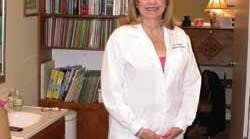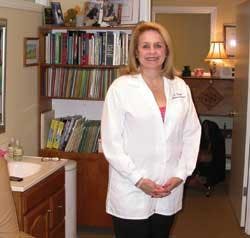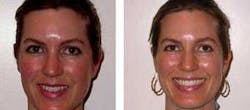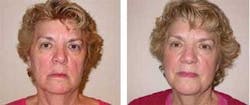A creative way to make a difference in patients' lives
Upon graduating from dental hygiene school in 1976, I worked full time in private practice until my wrist started hurting and my thumb on my scaling hand forced me to look at other options. I tried many different therapies, and the hand specialist told me surgery for my carpel tunnel was out of the question because I had a combination of arthritis and carpel tunnel.
This roadblock began my interesting, different career in dentistry. I am currently the happiest I have ever been in my professional life, working as a orofacial myofunctional therapist (OMT) in my own practice and teaching courses in this expanding field.
In Cardiff-by-the-Sea, Calif., I worked in a holistic dental office. I did the nutritional counseling as it related to dentistry, ran a group therapy session for “:phobic” dental patients, and assisted the doctor on Thursdays, which was TMD day. I learned about myofunctional therapy and began a private practice on a part-time basis.
I moved to Los Angeles in 2001 and continued a OMT private practice. I now have two offices — one in Pacific Palisades and the other in Beverly Hills. I also have had a satellite office in New York City where I trained some oral myologists to help patients. I teach five-day courses and a mini residency program for dental hygienists, speech pathologists, physical therapists, and related health care fields.
The OMT field has been interesting, rewarding, and is now emerging because of its connection to sleep apnea. There is a major shortage of therapists in the United States. Hygienists make excellent therapists because we already know the mouth, and we are trained to motivate patients. What OMTs do is teach patients how to chew, swallow, and breathe correctly. We work on habits, such as thumb sucking, that lead to poor muscle patterns, which can affect total body health.
So many exciting fields are related to dentistry where hygienists can build on the knowledge they have already acquired. Keep an open mind, become present in your profession, take continuing education classes, and keep a positive attitude.
The development of orofacial myofunctional therapy
The questions below can lead to discussion about the signs and symptoms of a patterning problem with orofacial muscles. They can be addressed by a hygienist who has training in the growing field of orofacial myofunctional therapy. OMT is a uniquely interesting specialty, rising out of orthodontics and later motivated and honed by individuals from speech-language pathology.1 The field is uniquely special because the therapist is making major life-enhancing changes that affect the entire body.
- Does your patient complain about chronic headaches?
- Does your patient have an open mouth rest posture?
- Has your patient's teeth moved after orthodontic treatment?
- Does your patient exhibit an open bite?2
- Does your patient complain of TMD or neck pain?
- Is the patient's tongue always “:in the way” when you are scaling his or her teeth?
- Does your patient exhibit a scalloped tongue from pressing against the teeth?
- Have you noticed oral habits such as thumb or finger sucking, nail biting, lip licking, or hair chewing?
- Does your patient “:lisp” when saying the “:s” sounds?
- Do you see the tongue come forward against the teeth when swallowing?
- Is your patient a mouth breather contributing to anterior gingivitis?
- Does your patient grind or clench his/her teeth?
- Does your patient have chronic stomach aches, burping, drooling, or hiccups?
- Does your patient have a forward head posture?
- Is your patient “:tongue-tied”?
- When you check for oral cancer on the sides of the tongue, have you found leukoplakia from the tongue thrusting into teeth, causing a chronic irritation?
The field is currently expanding to include many other disciplines. The interdisciplinary approach to patient wellness includes, but is not limited to, dental hygiene, periodontics, oral surgery, ear, nose and throat specialists, osteopathy, speech pathology, allergists, pediatric dentistry, pediatricians, physical therapists, chiropractors, gastroenterologists, and plastic surgeons.
The history behind OMT in the United States has been marked by almost 90 years of struggle because there is no specific university program in this field of study. Many speech pathologists have very limited training in this field, as do dental hygienists and physical therapists.
Many dentists during the 1800s and early 1900s recognized that tongue rest posture, mouth breathing, and oral habits influenced occlusion. Edward H. Angle, known as the grandfather of orthodontics, wrote a book in 19073. He recognized the influence of the facial muscles on dental occlusion and that mouth breathing was the chief etiological factor in malocclusion.
The field really began in 1918 with an article written by an orthodontist, Dr. Alfred P. Rogers,4 on “:Living Orthodontic Appliances” being the facial muscles. He was one of the first doctors who suggested that corrective exercises would develop tonicity and proper muscle function and thereby influence proper occlusion.
Today, many hygienists are taking courses to learn how to help their patients develop healthy muscle patterns. These patterns, when permanently habituated, can be proactive in preventing orthodontic problems, as well as articulation disorders and breathing disorders leading to allergies, TMD, digestive disorders, sleep apnea, and posture problems.
Some hygienists have opened their own private practices in myofunctional therapy and love the freedom and independence as well as the mental stimulation of learning something new. Also, they have a chance for their hands to rest by alternating hygiene with OMT. The real reward is helping patients end chronic pain and become healthy, happy people.
I have now been practicing orofacial myofunctional therapy for 30 years and have treated thousands of patients. My son experienced a problem when he was seven years old, and I witnessed the change in his teeth, headache pain, ADD issues, and TMD. The dramatic results motivated me to study everything available (at the time, Dan Garliner had an institute in Coral Gables, Fla., and Barbara Greene had an internship program in Hollywood, Calif.). I began a private practice in addition to my dental hygiene practice in 1978. I love the challenge of helping improve the quality of my patients' lives.
I have five different programs that I offer patients:
- Habit elimination therapy
- Mini–myo program for the young child
- Orofacial myofuncional therapy
- TMD and special needs therapy
- Cosmetic muscle toning for facial fitness
• Habit elimination therapy — My program for habit elimination treatment consists of three to five visits. I work with thumb and finger sucking, nail biting, hair chewing, tongue and lip sucking and chewing, and many other oral habits. I have a 95% success rate.
Everyone is born with a sucking habit; it is how one nurses for survival. Usually, at age nine months to 3 1/2 years, the child starts drinking from a cup and eating more solid foods and doesn't need to suck. However, many times a pacifier is used, or the child finds his or her thumb or another object, and the sucking habit is continued. At this point, the tongue is unable to rest and swallow correctly, leading to an open bite, cross bite, or some other type of malocclusion.
The program I developed uses behavior modification and positive reinforcement. The patient feels so proud to have ceased the habit once and for all! I feel the success of this program will empower the patients to control many obstacles in their lives that feel good, but they know is wrong for them. As a dental hygienist, I know the value of proactive therapy.
Some interesting statistics, which will motivate you to learn more about the field of habit elimination therapy, are from Rosemarie A. Van Norman5, an expert in the field of thumb sucking:
- 60% of malocclusion is caused by prolonged digit sucking
- 10% of 6-11 year olds suck
- 85% of digit suckers exhibit an open bite
- Open bites many times lead to TMD due to laterally shifting of the jaw in order to chew
- 49.9% of orthognathic surgery patients experience an open bite relapse
- 59% of digit suckers experience atypical root resorption
- 40% of digit suckers had learning and behavior problems in school
• The mini-myo program for the young child — Many times, young children can benefit from doing exercises to develop positive growth factors and eliminate negative growth pressures. The young child program has to be fun and fast to avoid burnout and disinterest. Because the bones are soft, the changes can be remarkably fast. I use a variety of rewards and behavior modification techniques. Parental support at home is essential.
Many oral motor exercises are done to achieve symmetry and control of saliva and the tongue. The young child program lasts about three to six months and can result in a major life-enhancing change.
The goals of the mini-myo program are:
- Encourage nasal breathing
- Develop a lip seal
- Implement a palatal tongue rest posture
- Encourage bilateral chewing
- Work on proper sleep posture as well as eating posture
- Introduce the “:bite, sip, and swallow back” motion
- Keep hands and objects away from the face
• Orofacial myofunctional therapy — This is my standard program for children and adults. It consists of a yearlong program of therapy exercises of the facial muscles and includes:
- Noxious habit elimination
- Teach nasal cleansing and nasal breathing
- Many different muscle therapy exercises to stretch, tone, and develop proper neuromuscular proprioception of the facial muscles
- Introduce the proper chewing and swallowing patterns
- Develop proper head and neck posture
- Habituation of the new patterns.
The first eight weeks of treatment are the most intensive period, followed by habituation of the new pattern.
• TMD and special needs therapy — These patients need an individualized program based on their physical limitations, pain factors, and ability to cooperate. I will always determine a specific treatment plan for the best result possible. The goals are the same as the other programs, but the methods are customized for the ability of the patient to perform. Special needs patients include those with autism, cerebral palsy, Down syndrome, chronic TMD caused by habits, attention deficit disorder, Bell's palsy, and sleep apnea.
These patients are scheduled on a per appointment basis and I take them as far as possible. I make no promises due to the compliance limitations. The patients really appreciate the help that no other specialty has been able to provide.
• Cosmetic muscle toning for facial fitness — There are more than 40 facial muscles which are different from other muscles in the body because they are all interconnected. Also, the facial muscles are the only muscles in your body that are attached to the skin. This allows for facial expression. What affects one muscle will affect others. I feel that this type of treatment will be the way of the future for orofacial myofunctional therapists.
People are tired of being cut, burned, injected, creamed and acid etched only to have gravity pull the muscles down again. The natural way would be to develop tone and fitness in the facial muscles similar to going to the gym to work out. A personal trainer will tell you that you have to stretch, lift weights, and do cardio three to four times a week in order to be fit. Why not exercise your face as well? This is another program a therapist can incorporate into his or her therapy program. The patients can come in groups or individually, and it is fun to bring the cosmetic value to them.
In Brazil, a plastic surgeon would not think of doing surgery without a trained orofacial myofunctional therapist to work with the muscles. How about the United States? With the baby boomers now all wanting a more youthful look, the future looks promising in this growing field. The field of cosmetic dentistry is growing. How about cosmetic orofacial myofunctional therapy? Many hygienists are incorporating exercises in with their hygiene practice as another way to have patients keep their recare visits.
How can the dental hygienist become involved?
Some dental hygiene programs include a course or lecture in orofacial myofunctional therapy just to teach the hygienist to recognize this disorder. Other programs have adopted a program with actual clinical exercises to treat patients with a myofunctional problems (Loma Linda, for example). Most programs have little or no information about the field. After 30 years of practicing and teaching courses in OMT, I feel the profession of OMT should become a specialty of dental hygiene, just as orthodontics is a specialty of dentistry. Speech pathologists also have little or no training in their college programs, but do receive referrals for tongue thrust therapy. They are usually uncomfortable doing treatment and get limited results unless they have taken a postgraduate course.
Currently, research in Brazil shows that OMT exercises can reduce moderate sleep apnea by 39%.6 This is very exciting because it will bring the medical profession and OMT together to treat this horrible disease that has killed so many people. I am currently joining the UCLA sleep medicine department to do more research. In the future, this will be a standard treatment for sleep apnea, so we will need an army of well trained therapists to meet the need.
Courses are available to dental hygienists as post-graduate education to become an orofacial myofunctional therapist. The courses are usually five intensive days with a recommendation to follow up with an internship. For more information, check out www.myoacademy.com or contact me at www.myofunctional-therapy.com.
References
- Mason RM. (2005) A Retrospective and Prospective View of Orofacial Myology, International Journal of Orofacial Myology
- Fujiki T, Inoue M. Miyawaki, S.,Nagasaki, T., Tanimoto, K., Takano-Yamamoto (Feb., 2004) Relationship between maxillofacial morphology and deglutitive tongue movement in patients with anterior open bite, AJO-DO American Journal of Orthodontics & Dentofacial Orthopedics
- Angle EH. Malocclusion of the teeth, ed. 7, Philadelphia, 1907, S. S.. White Manufacturing Co.
- Rogers AP. Exercises for the development of the face, with a view to increasing their functional activity, Dent. Cosmos 60:857
- Van Norman RA. Helping the Thumb-sucking Child., 1999
- Gulimaraes, Drager, Genta, Marcondes, Lorenzi-Filho. Effects of Oropharyngeal Exercises on Patients with Moderate Obstructive Sleep Apnea Syndrome, American Journal of Respiratory and Critical Care Medicine, Vol 179, 2009
About the Author
Joy L. Moeller, RDH, BS, graduated from dental hygiene school in 1976 from Prairie State College in Chicago Heights, Ill. She has lectured on orofacial myofunctional therapy at universities such as the University of Southern California, Cerritos, and UCLA. She can be contacted at [email protected].











